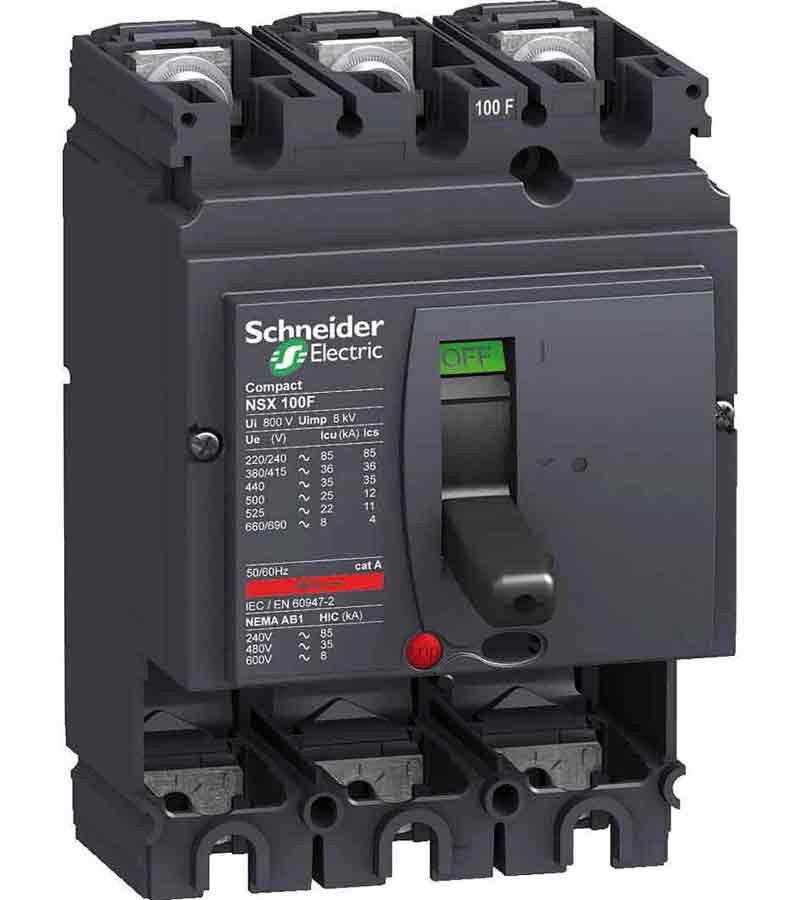Introduction:
MCB or MCCB are widely used in electrical distribution system for ON/OFF Electrical supply and it also gives over current and short circuit protection. Selection of MCB or MCCB involved technical, Mechanical parameters. Some parameters are important but some parameters are confusing and mislead to wrong selection of MCCB. Some parameters are directly affected on cost of MCCB.

Specification / Name Plate Details of MCB/MCCB:
Following specifications are required to select appropriate MCB or MCCB.
(A) Current Related:
- Frame Size (Inm): Amp
- Rated current (In/ Ie): Amp
- Ultimate short circuit breaking capacity (Icu): KA
- Rated short-circuit breaking capacity (Ics): % of Icu
(B) Voltage Related:
- Rated voltage (Ue): Volt
- Rated Insulation voltage (Ui): Volt
- Rated impulse withstand voltage(Uimp): KV
- No’s of Pole : SP,DP,TP,TPN,FP
(C) Application Type:
- Utilization Category/ Characteristic : B,C or D curve
(D) Accessories:
- Rotary Handle: Extended/ Direct
- Alarm Contact:
- Shunt Trip:
- Under voltage Trip:
- Mechanical interlocking:
- Manual /Auto operation
- Motorized Operation:
(E) Protection Type:
- Protection : Over current / Short circuit
- Trip Mechanism: Thermal / Magnetic / Solid / Microprocessor
- Trip Mechanism adjustment : Fixed / Adjustable
(F) Others:
- Frequency;
- Reference temperature: (if different from 30°C)
- Pollution degree:
- Suitability for isolation:
- Type of Mounting arrangement
- Electrical Life Cycles:
- Mechanical Life Cycles:
- Dimension: mm
- Weight: Kg
- Reference Standard: IEC: 60947-1/2, IS: 13947-1/2

(A) Current Related:
(1) Frame Size (Inm):
- Breaker Frame Size indicates the basic framework of the Plastic shell of MCCB that can hold the biggest rated current.
- It is the maximum current value for which the MCCB is designed (upper limit of the adjustable trip current range) and it also determines the physical dimensions of the device.
- There are varieties current ratings MCCB for the same series frame Size.
- For example, DX100 Frame Size MCCB for rated current of 16A, 20A, 25A, 32A, 40A, 50A, 63A, 80A, 100A.
- Same DX225 Frame Size MCCB for rated current of 100A, 125A, 160A, 180A, 200A, 225A.
- In above DX100 and DX225 has two Type of frame Size for rated current of 100A, but the shape and size of breaking capacity of circuit breakers is not the same.
(2) Rated Current (In /Ie):
- It is the current value above which overload protection is tripped.
- For MCB it is fixed while in MCCB the rated current is an adjustable range instead of a fixed value.
- Standard rating of MCB is 1A, 2A, 3A, 4A, 6A, 10A, 13A, 16A, 20A, 25A, 32A, 40A, 50A, 63A, 100A for MCB.
(B) Voltage Related:
(3) Ultimate short-circuit breaking capacity (Icu):
- Breaking capacity can be defined as the maximum level of fault current which can be safely cleared.
- It is the highest fault current that the MCCB can trip without being damaged permanently.
- The MCCB will be reusable after interrupting a fault, as long as it doesn’t exceed this value.
- It is indicate operation reliability of MCCB
- This parameter may increase or decrease the cost, so it should be properly decided. Breaking capacity should be higher than the possible fault level. For domestic application fault level may be 10kA.

(4) Operating short-circuit breaking capacity (Ics):
- It is expressed as a percentage ratio of Icu and tells you the maximum short-circuit current if a circuit breaker can break three times and still resume normal service.
- The higher the lcs, the more reliable the circuit breaker
- It is the maximum possible fault current that the MCCB can clear. If the fault current exceeds this value, the MCCB will be unable to trip and another protection mechanism must operate.
- If a fault above the Ics but below the Icu occurs, the MCCB can interrupt it successfully but will need a replacement due to the damage suffered.
- The Main difference between Ultimate Short Circuit (Icu) and Service Breaking Capacity (Ics) that Icu (Ultimate Braking Capacity) means Circuit breaker can remove the fault and remain usable but Ics (Service Braking Capacity) means Circuit breaker can remove the fault, but it may not be usable afterwards.
- For example, if a circuit breaker has an Ics of 25,000 Amperes and an Icu of 40,000 Amperes:
- Any fault below 25kA will be cleared with no problem.
- A fault between 25kA and 40kA will cause permanent damage when cleared.
- Any current exceeding 40 kA can’t be cleared by this breaker.
(5) Rated working voltage (Ue):
- It is the continuous operation voltage for which the MCCB is designed.
- This value is typically equivalent or close to a standard system voltage.
- In three phase it is usually 400V or 415 V. For single phase it is 230V or 240V.
(6) Rated Insulation voltage (Ui):
(7) Rated impulse withstands voltage (Uimp):
- It is the maximum voltage that the MCCB can resist according to laboratory tests.
- It is higher than the rated working voltage, in order to provide a margin of safety during field operation.
- It is the value of transient peak voltage the circuit-breaker can withstand from switching surges or lighting strikes imposed on the supply.
- This value characterizes the ability of the device to withstand transient over voltages such as lightning (standard impulse 1.2/50 μs).
- Uimp = 8kV means Tested at 8 kV peak with 1.2/50μs impulse wave.
(8) Number of Poles:
- No of Pole for MCCB depends on Single Phase & Three Phase Power Controlling /Protection
- Single Pole (SP) MCB:
- A single pole MCB provides switching and protection for one single phase of a circuit.
- Used: for Single Phase circuit
- Double Pole (DP) MCB:
- A two Pole MCB provides switching and protection both for a phase and the neutral.
- Used: for Single Phase circuit
- Triple Pole (TP) MCB:
- A triple/three phase MCB provides switching and protection only to three phases of the circuit and not to the neutral.
- Used: for Three Phase circuit
- 3 Pole with Neutral (TPN (3P+N) MCB):
- A TPN MCB, has switching and protection to all three phases of circuit and additionally Neutral is also part of the MCB as a separate pole. However, Neutral pole is without any protection and can only be switched.
- Used: for Three Phase circuit with Neutral
- 4 Pole (4P) MCB:
- A 4 pole MCB is similar to TPN but additionally it also has protective release for the neutral pole. This MCB should be used in cases where there is possibility of high neutral current flow through the circuit as in cases of an unbalanced circuit.
- Used: for Three Phase circuit with Neutral
(9) Utilization category / Characteristic (B, C, D, K, Z curve):
- Characteristic of Trip curves of MCCB tell about the trip current rating of MCCB.
- MCB will trip instantaneously according to their Tripping Characteristic at 0.1 sec.
- There are various type of MCCB
- Type B MCCB
- Type C MCCB
- Type D MCCB
- Type K MCCB
- Type Z MCCB

Type B MCCB:
- Operating Current: This type of MCB trips between 3 and 5 times rated current (In).
- Operating Time:04 To 13 Sec
- For example a 10A device will trip at 30-50A.
- Application: Domestic applications or light commercial applications where connected loads are primarily lighting fixtures, domestic appliances with mainly restive elements.
- Suitable for: Restive Load application (Lighting , Small Motor)
- Surge Current: The surge current level is relatively low.
- Installation at: At Sub feeder of Distribution Board.
Type C MCCB:
- Operating Current: This type of MCB trips between 5 and 10 times full load current.
- Operating Time:04 To 5 Sec
- Application: commercial or industrial type of applications, fluorescent lighting, motors etc where there could be chances of higher values of short circuit currents in the circuit.
- Suitable for: Inductive Load application (Pumps, Motor, fluorescent lighting.)
- Surge Current: The surge current level is relatively moderate level.
- Installation at: At incoming / Outgoing of Distribution Board.
Type D MCCB:
- Operating Current: This type of MCB trips between 10 and 20 times full load current.
- Operating Time:04 To 3 Sec
- Application: specialty industrial / commercial uses (Transformers or X-ray machines, large winding motors, discharge lighting, large battery charging). Where current inrush can be very high.
- Suitable for: Inductive- Capacitive Load application (Pumps, Motor)
- Surge Current: The surge current level is relatively High
- Installation at: At incoming of Distribution Board / Panels.
Type K MCCB:
- Operating Current: This type of MCB trips between 8 and 12 times full load current.
- Operating Time:04 To 5 Sec
- Application: Suitable for inductive and motor loads with high inrush currents.
- Surge Current: The surge current level is relatively High
- Installation at: At incoming of Distribution Board / Panels.
Type Z MCCB:
- Operating Current: This type of MCB trips between 2 and 3 times full load current.
- Operating Time:04 To 5 Sec
- Application: These types of MCBs are highly sensitive to short circuit and are used for protection of highly sensitive devices such as semiconductor devices.
- Surge Current: The surge current level is relatively too low
- Installation at: At Sub feeder of Distribution Board for IT equipment.
(D) Accessories:
(1) Rotary Handle:

- It is used to extend ON/OFF handle of MCCB when Panel Door is closed.
- It is also used to indicate ON/OFF or Trip Position
(2) Shunt Trip:

- Used for Remote Tripping
(3) Alarm contact:

- It gives Tripping Indication when MCCB Trip.
- It does not give when MCCB is in normal condition (either ON or OFF)
(4) Auxiliary contact:

- It used for remote signaling and control purpose.
- It is also give ON/OFF indication of MCCB at remote location.
(5) Under Voltage Tripping:

- It used to trip MCCB in under voltage condition (70 to 35% of rated Voltage).
(6) Mechanical Interlocking:

- It used to mechanical interlock of two MCCB on the same Panel.
(7) Manual / Auto:
- MCCB may have provision for Auto /Manual operation.
- An “auto/manual” switch in front of Panel.
- When set to the “Manual” position, lock out electrical control and when set to “auto”, lock out the manual control; remote indication
(8) Motorized operation:
- MCCB may have option for manual operation or with a motor mechanism for electrically controlled
(E) Others:
(1) Frequency:
- MCB is designed and used in AC power system of 50 to 60Hz.
- Electromagnetic force of magnetic release is related with power supply frequency so If Frequency is changed than electromagnetic fore of Magnetic element is changed hence MCCB tripping current will be different.
- If we used MCCB for protection in DC circuits than specially design DC circuit MCCB should be used rather than normal type of MCCB.
(2) Isolation:
- MCCB is suitability for visible isolation. It is particularly important.
- If a circuit breaker is turned off, it should indicate so visibly.
- It should not be able to indicate otherwise if the contacts are not open. In other words, it offers proof of isolation.
(3) Type of Mounting Arrangement:
- According to mounting arrangement, MCBs can be divided into two categories.
- DIN rail mount MCCB
- Plug-in MCCB
- DIN Rail Mount MCB
- The main advantage of this type of MCB is versatility
- DIN rails are used by many different types of electrical and communications equipment, and they are mainstream in industrial settings.
- They can be easily integrated into nearly any control or protection system.
- A disadvantage of this type of MCB is that more work is required for installation, and plug-in MCBs may be a better choice for simple installations.
- Plug-In MCB
- These MCBs are easy for installation. As name indicates, they just have to be plugged into a compatible electric panel.
- Plug-in MCBs are suitable for applications that use circuit breakers exclusively- typically residential and commercial electrical distribution systems.
- When using plug-in MCBs it is important that the breakers and the panel must match. It is not an issue when both are of the same brand
(4) Pollution degrees:
- It determines in what kind of environment circuit breakers can be installed.
- In a Domestic purpose where there is no dust no humidity, the circuit breaker is comfortable.
- For Domestic purpose pollution degree 2 is suitable.
- But in an outdoor public installation where there may be dust which cause leakage currents and lead to dangerous arcs.
- For dusty pollution, humidity environment or outdoor type heavy-duty applications (incoming switchboards) pollution degree 3 is suitable.
(5) Energy Class:
- MCB need some time for tripping, In this time, fault current will create some energy which will exist in system.
- This energy is termed as release energy. For efficient MCB operation it should be in within limited. On basis of amount of release energy it is classified in class 1, class 2 and class 3.
- Class 3 is best which allows maximum 1.5L joule/second.

